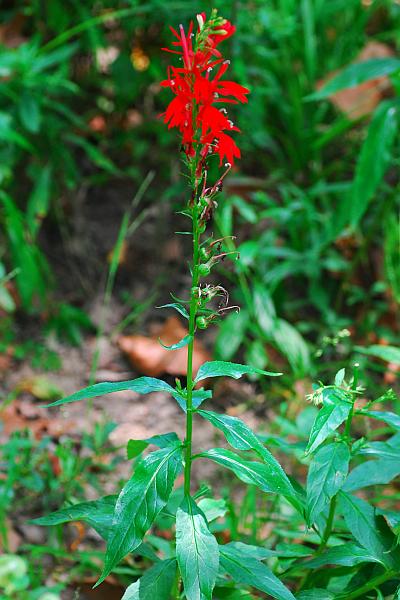Lobelia cardinalis L.
Cardinal Flower

Native
CC = 6
CW = -3
MOC = 61
© SRTurner
Lobelia cardinalis L.Cardinal Flower | |
 |
Native CC = 6 CW = -3 MOC = 61 |
© SRTurner |
|
Family - Campanulaceae Habit - Fibrous-rooted perennial forb. Stems - Ascending to erect, to 1.5 m, simple or few-branched toward the tip, angled, glabrous or rarely with sparse, short hairs, with milky sap.
Leaves - Alternate, simple, mostly petiolate. Petioles 1-2 cm long, gradually reduced upward. Leaf blades 2-15 cm long, 0.5-4.0 cm wide, narrowly lanceolate to oblanceolate or narrowly ovate, angled or tapered at the base, angled or tapered to a sharply pointed tip, the margins shallowly or irregularly toothed and often sinuous, the surfaces glabrous or sparsely and inconspicuously pubescent with short, curved hairs.
Inflorescence - Terminal racemes with 10-40 flowers, the bracts of the lower flowers leaflike, the upper bracts much shorter (each flower also with a pair of minute bracts immediately below the calyx). Pedicels to 5 mm, puberulent to strigose.
Flowers - Calyces 9-15 mm long, the tube 3-5 mm long at flowering, enlarging as the fruit matures, the slender lobes 6-12 mm long, becoming noticeably elongated as the fruit matures, lacking auricles. Corollas strongly zygomorphic, resupinate, bilabiate, 25-45 mm long, bright red, the outer surface glabrous, the corolla tube 15-30 mm long, with slitlike openings (fenestrate), the apparent lower lip 3-lobed, the upper lip 2-lobed and split nearly to the base, the lobes 14-20 mm long. Stamens 5. Filaments fused into a tube 18-30 mm long, red, the anther tube 3-5 mm long. Stigma 2-lobed.
Fruits - Hemispheric capsules 6-10 mm long, enclosed in persistent calyx and ornamented with persistent floral parts, longitudinally dehiscent by 2 apical pores. Seeds 0.6-1.0 mm long, ovoid to ellipsoid, the surface with a series of minute pits and ridges, sometimes also with minute, irregular tubercles, yellowish brown.
Flowering - July - October. Habitat - Streambanks, bottomland forest openings, swamps, sloughs, ditches, wet roadsides. Also cultivated. Origin - Native to the U.S. Lookalikes - None. Silene regia also has bright red flowers but these have a totally different form. Other info. - This is easily the most striking species of Lobelia which occurs natively in Missouri. It is found in wet places throughout much of Missouri, though is apparently absent from a swath of northwestern counties. It also occurs across much of the continental U.S. with the exception of several northwestern states. The intensely red flowers are conspicuous and make flowering plants impossible to mistake for anything else. The plant makes for a beautiful display in a garden setting which remains constantly moist throughout the season. The flowers are very attractive to butterflies and hummingbirds. Like other members of the genus, this species contains piperidine alkaloids (often erroneously labeled "pyridine" alkaloids) and should be considered toxic. Photographs taken in Brown Summit, NC., 7-31-02 and along the shores of the Current River, Shannon County, MO., 8-15-03 (DETenaglia); also near Pacific, St. Louis County, MO, 8-11-2010, at Onondaga Cave State Park, Crawford County, MO, 9-5-2011, Hickory Canyons Natural Area, Ste. Genevieve County, MO, 8-30-2017, and Creve Coeur Lake Park, St. Louis County, MO, 8-30-2021 (SRTurner). |